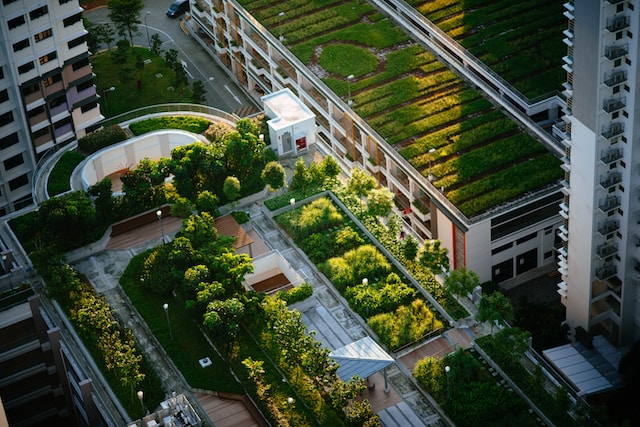Sustainable Architecture in Denver -
How It Is Revolutionizing the City Landscape
Denver natives have seen how architecture has transformed the city over time. From old brick warehouses being converted into trendy lofts to skyscrapers popping up in the downtown district, there's truly no shortage of cool and unique buildings around town. However, it wasn't until recently that people started paying attention to sustainable architecture in Denver. And let us tell you this - it's changing the face of our urban landscape.
What is Sustainable Architecture?
Before we dive deep into how sustainable architecture is revolutionizing Denver's skyline, let's first understand what exactly is meant by "sustainable architecture." Simply put, sustainable architecture is all about designing and constructing buildings in a way that minimizes their negative impact on the environment.
Take, for example, buildings with green roofs. These are essentially gardens on top of buildings that serve multiple purposes, such as providing insulation or reducing greenhouse gas emissions. Then there are those made with recycled materials like shipping containers or tires.
While these may sound like mere eco-friendly options to some, they're actually major contributors to our planet's longevity. After all, as citizens and residents of any state or municipality, we must bear some corporate responsibility toward our environment.

Why Is Sustainable Architecture So Important in Denver?
With rapid population growth and an influx of businesses moving into Denver comes great responsibility- that is where Sustainability in Architecture comes handier than ever. All this new development also means an added strain on our natural resources: more energy consumption, water usage, etc. In order to mitigate these environmental impacts without sacrificing modern-day advantages like rooftop barbecues with friends after a long workweek, building sustainably should be part and parcel of a way of living for local communities.
Examples of Sustainable Architecture in Denver
Now that we've established why sustainable architecture (Denver) is so important for our city's growth, it's time to take a look at some prime examples.
River North Art District, or RINO as locals call it, has been at the forefront of sustainability through architecture and urban design. Dubbed "one of the top five emerging neighborhoods in America'' by Forbes magazine, River North is both trendy and highly eco-conscious. Case in point: The Source Marketplace includes multiple artisan food producers and restaurants housed within a formerly abandoned 1880s brick foundry building. Restored with reused materials, this award-winning project serves not only as a place for foodies but also has evolved into a community hub that attracts both tourists and locals alike.
Another project which attests to sustainability being key to creating liveable spaces includes - "The Sustainability Park," initiated by Green Ovation Homes. This park incorporates net-zero energy homes with built-in features such as solar panels, a smart home system, IoT-based automation solutions, etc. The concept behind the development was more than simply homes reduced carbon footprints!! As much as a green technology, these homes had solid insulation and fashionably designed interiors curated sustainably, thus promoting healthy living from personal hygiene habits like taking breaks when using screens (so sleeping well) to using non-toxic paints!
Denver's Union Station neighborhood assimilates adaptive reuse aesthetics grounded on clean energy. Resurrecting Union Station from its pockmarked existence due to the mid-2000s recession once again injected life into one structurally significant locale. Incorporating innovative approaches such as evaporative cooling systems & low-flow toilets, also recycling materials like wood planks -the Union Station Revitalization elevated Denver from a railroad town to an entertainment hub.
Sustainable Architecture is Becoming More Commonplace
It's not just these buildings that make a difference in our city - sustainable architecture is increasingly becoming the norm amongst developers and architects alike. One major development that brought to the fore this transition was the creation of the Colorado Building Code mandating the eco-friendly sourcing of energy and building techniques. Another project highlighting the same involves Transamerica Pyramid (2195 Blake Street), set to become one of North America's most innovative LEED-Platinum structures integrating green facade technology with a cogeneration system contributing towards absorption, lower energy consumption & hence reduced emissions from car-dominated traffic. Surely, increasing accessibility and affordability makes it easier for people like you and me to enhance sustainability on a personal level as well.
Final Thoughts
As time passes by & as we continue developing communities, integrating sustainability principles has become an obligation rather than a choice. The demand for sustainable architecture in Denver is only growing, with more businesses adopting it every day. Today, walking down streets such as Broadway or Santa Fe Drive- gives nostalgic vibes seeing traditional characteristics of older buildings being preserved along quaint sidewalks blending ably into a classy atmosphere that resembles chic rooftop bars nestled amidst green-skewed walls. So next time you're out in Denver, look around with greater scrutiny and perhaps offer a little appreciation to those innovative structures relaying tales silently. Technological wisdom combined with roguish ecological edginess - that's sustainability coupled up.